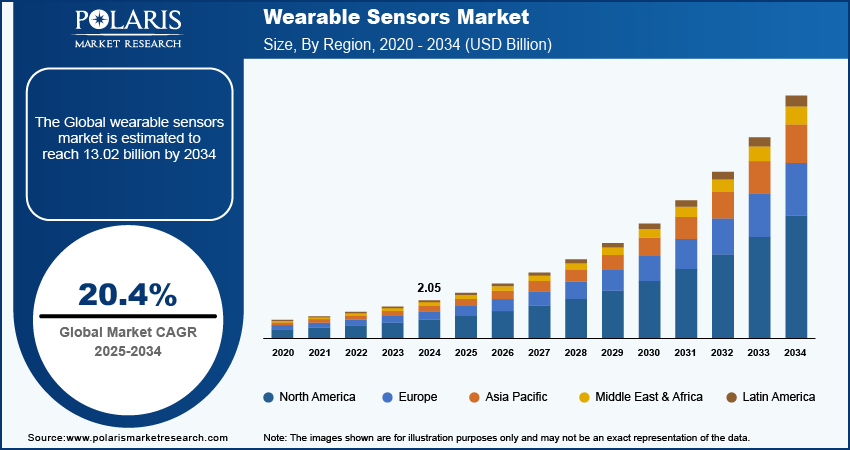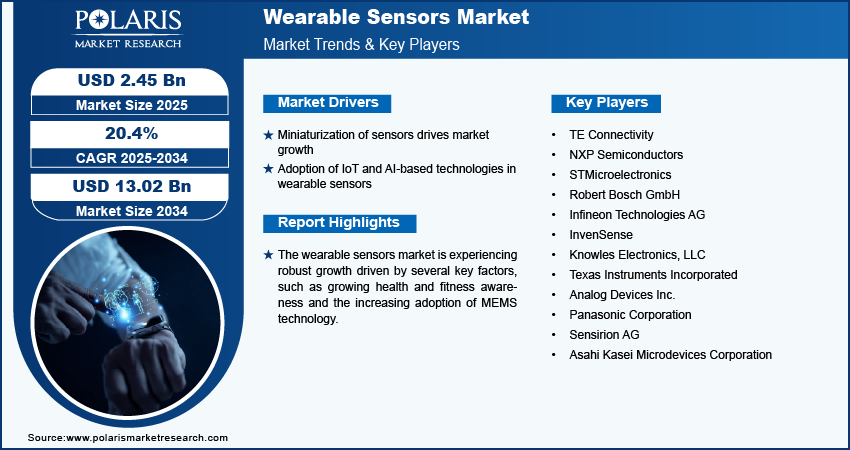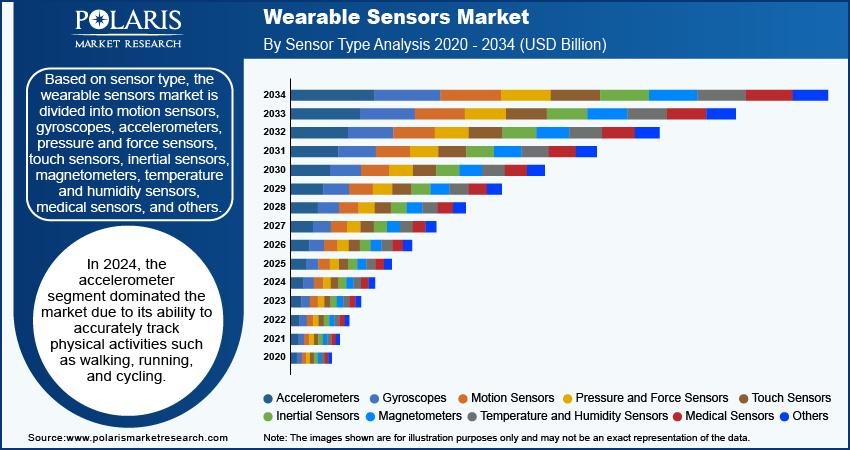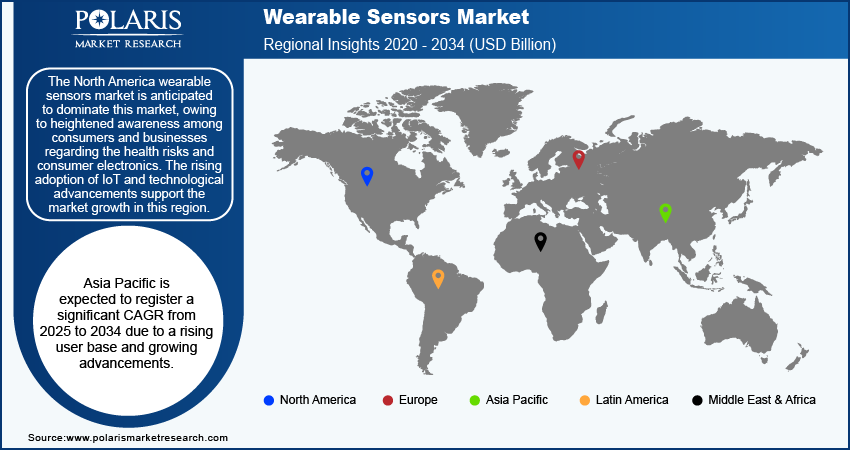
Wearable Sensors Market Size, Share, Trends, Industry Analysis Report: By Sensor Type, Technology, Device (Smartwatch, Fitness Band, Smart Glasses, Smart Fabric, Smart Footwear, and Others), End Users, and Region (North America, Europe, Asia Pacific, Latin America, and the Middle East & Africa) – Market Forecast, 2025–2034
- Published Date:Nov-2024
- Pages: 120
- Format: PDF
- Report ID: PM1470
- Base Year: 2024
- Historical Data: 2020-2023
Wearable Sensors Market Overview
The wearable sensors market size was valued at USD 2.05 billion in 2024. The market is projected to grow from USD 2.45 billion in 2025 to USD 13.02 billion by 2034, exhibiting a CAGR of 20.4% from 2025 to 2034.
Wearable sensors are advanced devices designed to monitor and collect data about an individual's physiological and biochemical parameters in real-time, often in a non-invasive manner. These sensors are integrated into various wearable technologies, such as smartwatches, fitness trackers, smart clothing, and even tattoo-like devices. They serve multiple purposes, including health monitoring, fitness tracking, and providing insights into personal well-being.
The wearable sensors market is experiencing robust growth driven by several key factors, such as growing health and fitness awareness and the increasing adoption of MEMS technology. People are focusing on their well-being and actively seeking ways to monitor their health metrics. Wearable sensors integrated into fitness trackers, smartwatches, and other devices provide real-time data on pulsation rate, sleep patterns, activity levels, and more. This data empowers individuals to make informed choices about their health and fitness routines.
MEMS technology allows for the miniaturization of sensors, making them smaller, lighter, and more energy-efficient. This miniaturization enables seamless integration of these sensors into various wearable devices, enhancing their functionality and user comfort. The ongoing advancements in MEMS technology are expected to lead to the development of even more sophisticated and versatile sensors, further driving market growth.

To Understand More About this Research: Request a Free Sample Report
Rising disposable incomes, especially in developing economies, are a major factor driving the wearable sensors market. Wearable sensors that monitor physical activity, heart rate, and sleep patterns align well with this trend. People are now able to invest in advanced health and fitness trackers due to their improved financial situations. This growing willingness to spend on advanced wearable technology is leading to a significant increase in market revenue.
Wearable Sensors Market Trends and Drivers Analysis
Miniaturization of Sensors
The miniaturization of sensors is transforming the wearable device market by allowing sophisticated monitoring capabilities to be incorporated into smaller designs. This advancement makes wearable technology more appealing as devices can now perform complex functions. The ability to include powerful sensors in smaller packages caters to consumers looking for efficient and user-friendly health and fitness monitoring solutions. Miniaturization allows for the development of compact, comfortable, and functional wearable devices like the OHSU-ADI smartwatch, a device developed in December 2022 by Oregon Health and Science University (OHSU) in collaboration with Analog Devices, Inc (ADI). This smartwatch serves as an early detector of suicidality or depression among teenagers, offering precise, continuous health data unobtrusively, making it suitable for everyday use by individuals of all ages. As a result, the miniaturization of sensors is a major driver of market growth.
Adoption of IoT and AI-Based Technologies in Wearable Sensors
The adoption of IoT (Internet of Things) and AI (artificial intelligence) technologies in wearable sensors significantly boosts their demand by enhancing functionality, improving user experience, and expanding applications in healthcare and personal wellness. AI algorithms improve the accuracy of data collected by wearable sensors, enabling better detection of health issues. For instance, AI corrects inaccuracies in heart rate measurements, ensuring reliable data for users and healthcare providers. This reliability increases trust in wearable devices, encouraging more consumers to adopt them.

Wearable Sensors Market Segment Analysis
Wearable Sensors Market Assessment by Sensor Type
Based on sensor type, the wearable sensors market is segmented into motion sensors, gyroscopes, accelerometers, pressure and force sensors, touch sensors, inertial sensors, magnetometers, temperature and humidity sensors, medical sensors, and others. In 2024, the accelerometers segment dominated the market due to its ability to accurately track physical activities such as walking, running, and cycling. They provide precise measurements of movement and orientation, enabling wearable devices to differentiate between various types of physical activity. This capability is essential for fitness enthusiasts who seek detailed insights into their performance and activity levels. Moreover, the rise of smartwatches, which generally incorporate accelerometers, has significantly contributed to the demand for these sensors.
Wearable Sensors Market Evaluation by Device
Based on device, the wearable sensors market is segmented into smartwatches, fitness bands, smart glasses, smart fabric, smart footwear, and others. The fitness band segment is expected to experience significant growth in the market. This growth is driven by increasing demand from young consumers for affordable fitness trackers and continuous technological advancements. In March 2023, Infineon Technologies introduced SECORA Connect X, a low-power NFC chip designed for fitness bands, rings, and smartwatches. This integrated solution enables secure contactless payments and wireless charging, ultimately enhancing user experience due to its compact size and efficiency, which boosts battery life. Such developments are expected to drive the market growth.

Wearable Sensors Market Breakdown by Regional Insights
By region, the study provides market insights into North America, Europe, Asia Pacific, Latin America, and the Middle East & Africa. The North America wearable sensors market dominated the market share, owing to heightened awareness among consumers and businesses regarding health risks and consumer electronics. The rising adoption of IoT and technological advancements also support the market growth in this region.
The key market players are merging, acquiring, and collaborating to strengthen their market presence and serve better offerings in North America, further driving the market during the forecast period. The United States has garnered the largest market share in the region due to the rising consumer health awareness and growing healthcare sector.
The Asia Pacific, wearable sensors market, is expected to register the fastest CAGR from 2025 to 2034 due to the growing user base and increasing disposable incomes. Moreover, growing urbanization, expanding e-commerce industry, and advancement in technology are propelling the growth of the region. China is expected to witness significant growth in the region during the forecast period, owing to the presence of major technology companies.

Wearable Sensors Market – Key Players & Competitive Analysis Report
Major market players are investing heavily in research and development in order to expand their product lines, which will help the wearable sensors market grow even more. Market participants are also undertaking a variety of strategic activities to expand their global footprint, with important market developments including new product launches, contractual agreements, mergers and acquisitions, higher investments, and collaboration with other organizations. To expand and survive in a more competitive and rising market environment, the wearable sensors industry must offer cost-effective items.
Manufacturing locally to minimize operational costs is one of the key business tactics used by manufacturers in the wearable sensors market to benefit clients and increase the market sector. In recent years, the market has witnessed some technological advancements. Major players in the wearable sensors market include Infineon Technologies AG; Texas Instruments Inc.; Broadcom Limited; Asahi Kasei Microdevices Corporation; NXP Semiconductors N.V.; Robert Bosch GmbH; Invensense, Inc.; TE Connectivity Ltd.; Knowles Electronics, LLC; and Panasonic Corporation.
Infineon Technologies AG is a semiconductor manufacturer known for its wide range of solutions. It specializes in automotive, industrial, and consumer electronics, providing innovative technologies to enhance energy efficiency, mobility, and connectivity. In July 2024, Infineon unveiled an Edge AI evaluation kit for creating machine learning applications for wearables.
STMicroelectronics is an integrated device manufacturer (IDM) specializing in semiconductor solutions. It recently introduced advanced wearable sensors for improved health and fitness tracking, ideal for consumer and medical applications.
List of Key Companies in Wearable Sensors Market
- Infineon Technologies AG
- Texas Instruments Inc.
- Broadcom Limited
- Asahi Kasei Microdevices Corporation
- NXP Semiconductors N.V.
- Robert Bosch GmbH
- Invensense, Inc. (TDK Corporation)
- TE Connectivity Ltd.
- Knowles Electronics, LLC
- Panasonic Corporation
- Analog Devices Inc.
Wearable Sensors Market Developments
May 2024: Asahi Kasei announced a new facility in Port Colborne, Ontario, Canada. This facility will be dedicated to manufacturing lithium-ion battery separators. This move demonstrates Asahi Kasei's commitment to supporting the wearable sensors market by improving battery technologies essential for portable and wearable devices.
January 2023: Asahi Kasei Corporation unveiled the AK09940A, a 3-axis magnetic sensor designed for superior motion tracking in AR/VR and wearables. Its exceptional low noise and power consumption enhance accuracy in these applications. The sensor excels at pinpointing subtle magnetic field changes, enabling precise fault and position detection. Notably, its energy efficiency makes it ideal for battery-powered wearables and IoT devices.
October 2023: Infineon Technologies AG introduced the XENSIV radar sensors for sleep tracking, which are integrated into wearables. They offer detailed sleep data on stages and respiration, improving user health awareness and boosting the wearable sensors market.
May 2024: Bosch Ventures made strategic investments in cleantech, including battery recycling technologies. According to Bosch, these investments are crucial for the development and maintenance of high-performance batteries used in wearable sensors, contributing to the overall sustainability and efficiency of wearable technology.
Wearable Sensors Market Segmentation
By Sensor Type Outlook
- Motion Sensors
- Gyroscopes
- Accelerometers
- Pressure and Force Sensors
- Touch Sensors
- Inertial Sensors
- Magnetometers
- Temperature and Humidity Sensors
- Medical Sensors
- Others
By Technology Outlook
- MEMS
- CMOS
- Others
By Device Outlook
- Smartwatch
- Fitness Band
- Fitness Bands
- Smart Glasses
- Smart Fabric
- Others
By End Users Outlook
- Consumer
- Healthcare
- Industrial
- Defense
- Others
By Regional Outlook
- North America
- US
- Canada
- Europe
- Germany
- France
- UK
- Italy
- Spain
- Netherlands
- Russia
- Rest of Europe
- Asia Pacific
- China
- Japan
- India
- Malaysia
- South Korea
- Indonesia
- Australia
- Rest of Asia Pacific
- Middle East & Africa
- Saudi Arabia
- UAE
- Israel
- South Africa
- Rest of the Middle East & Africa
- Latin America
- Mexico
- Brazil
- Argentina
- Rest of Latin America
Wearable Sensors Report Scope
|
Report Attributes |
Details |
|
Market Size Value in 2024 |
USD 2.05 billion |
|
Market Size Value in 2025 |
USD 2.45 billion |
|
Revenue Forecast in 2034 |
USD 13.02 billion |
|
CAGR |
20.4% from 2025 to 2034 |
|
Base Year |
2024 |
|
Historical Data |
2020–2023 |
|
Forecast Period |
2025–2034 |
|
Quantitative Units |
Revenue in USD billion and CAGR from 2025 to 2034 |
|
Report Coverage |
Revenue Forecast, Market Competitive Landscape, Growth Factors, and Trends |
|
Segments Covered |
|
|
Regional Scope |
|
|
Competitive Landscape |
|
|
Report Format |
|
|
Customization |
Report customization as per your requirements with respect to countries, regions, and segmentation. |
FAQ's
The wearable sensors market size was valued at USD 2.05 billion in 2024 and is projected to grow to USD 13.02 billion by 2034
The market is projected to register a CAGR of 20.4% from 2025 to 2034.
North America is anticipated to dominate the market.
The key players in the market are Infineon Technologies AG; Texas Instruments Inc.; Broadcom Limited; Asahi Kasei Microdevices Corporation; NXP Semiconductors N.V.; Robert Bosch GmbH; Invensense, Inc.; TE Connectivity Ltd.; Knowles Electronics; LLC; and Panasonic Corporation.
The accelerometer segment dominated the market in 2024.
The fitness band segment is anticipated to experience significant growth in the market.
